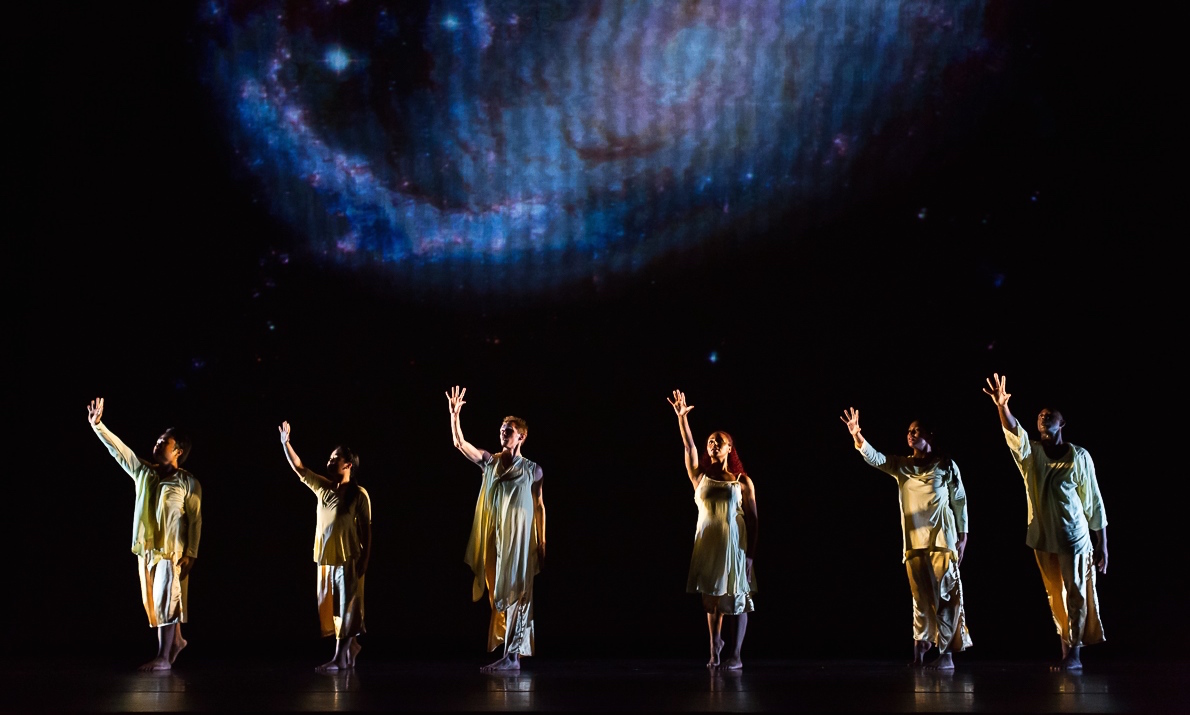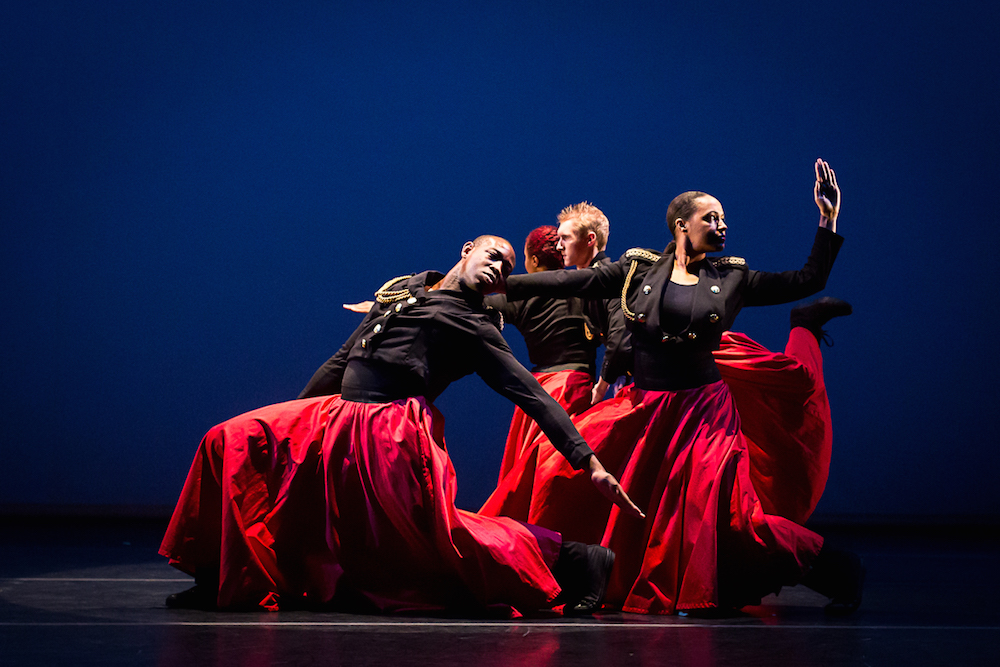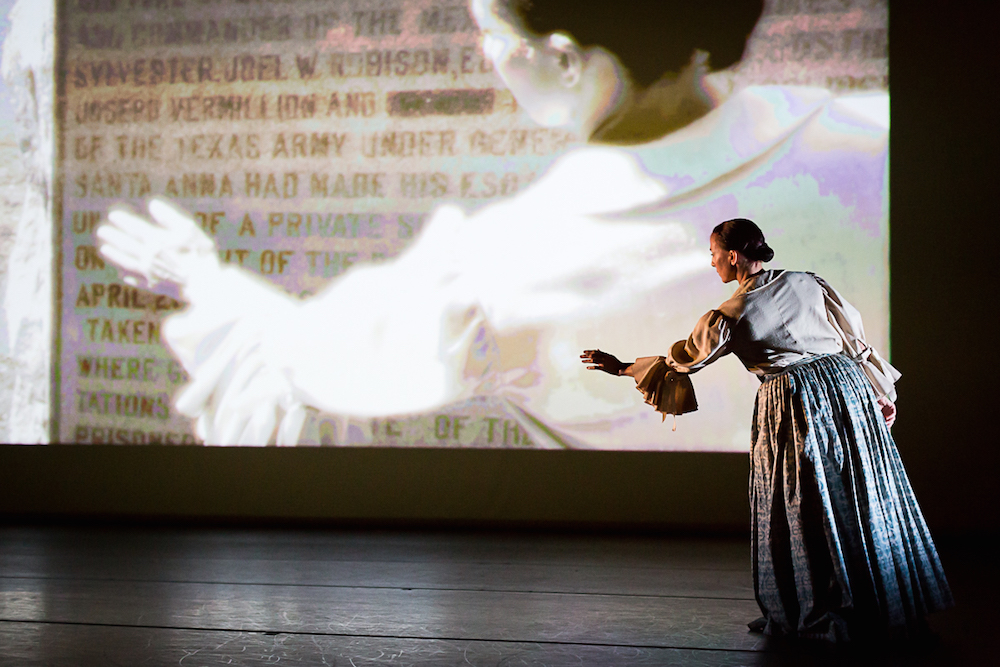Karen Stokes Dance – DEEP: Seaspace

Photo by Lynn Lane
October 20-22, 2016, Zilkha Hall, The Hobby Center
by Neil Ellis Orts
DEEP: Seaspace was already in progress as the audience filtered in. Audio interviews with Houston Ship Channel captains play as performers in white, baggy jumpsuits take slow, stiff steps across the stage. They pause, turn to the audience, and offer enigmatic stares before continuing on their way. We’d see this movement occur throughout the evening.
When the music, composed by Bill Ryan, begins, video projection lights up the backdrop. We see ships passing on the ship channel, men fishing from the shore. A boy appears, walking down to the water with his fishing pole but discovers, in some turned soil on the bank, a box which contains an old hair brush, a map of the San Jacinto battlefield, a letter signed by Santa Anna, toy soldiers, and a key—obviously, a time capsule from the 1800s.

Photo by Lynn Lane
There are dancers, too, of course. (I digress momentarily to celebrate unisex costumes that don’t default to traditionally male clothing—there is a sequence where the mixed gender group are wearing black, military-style shirts with red, full-length skirts. Yes!) Duos and groups dance on ship decks and on shore. We’re taken to a graveyard, filled with tombstones with dates from the 19th Century. A woman rises from one of the graves and wanders through the rest of the film and then onto the stage. She carries the box of artifacts with her, into the 21st Century. Her presence comes and goes throughout the rest of the evening, observing, never interacting, simply present.
The choreography, as it unfolds, is a series of implied settings and costume changes. Red work jumpsuits complete with red hardhats alternate with the black and red ensemble described above and white and gold, flowing costumes that might be more usually expected in a dance concert. The movement vocabulary is heavily gestural and pedestrian movement—there is a lot of walking in the choreography—and the tempo and emotional content feels controlled for most the evening.
Ryan’s music is similarly steady, within a fairly narrow range of mood and style and tempo. It felt very modern, somewhere in the same musical gene pool of John Adams. In this the choreography and music were fine matches for one another. They certainly seemed of a piece, with shared intentions.

Photo by Lynn Lane
It is clear that Stokes has a narrative in mind. That her medium is contemporary dance leaves space for interpreting what it all means. (Overheard at intermission: “Did you see all that turning? That’s the ships’ propellers.”) What I experienced was an impressionist look at this one geographical area, a piece of land and water on which humanity has fought wars and aimed for the stars. In the roughly 170 years of Stokes’ concern—barely a blip in geological time—these waters have seen human blood and commerce, quiet days of fishing and rocket fuel. What we find is that all of it exists there, all at once. The ghost, in her 1800s garb and carrying the box of mementos, is a thread that is sewn through the narrative, gathering the material. Is she creating the folds of history or merely pointing them out? The ghost’s cool, cryptic presence doesn’t tell for certain.
There is a section in the second act, the “Space” act, wherein two dancers (Jerrica Mark and Bryan Peck) have an extended duet. Until this lyrical, lovely moment, I hadn’t realized how little the dancers personally interacted throughout the evening. Brief contact, yes, but no extended touch. Their partnering and tenderness drew attention to the earlier moments that, in retrospect, felt more focused on the impersonal work, not exactly business-like, but certainly more concerned with matters of industry than the human element behind it all.
Planets and galaxies appear on the backdrop and Stokes brings us to a point of wonder in the final movements of the evening. The immense projections are both aspirational and calls into question our small lives. The dancers gesture upward in awe while bending under the weight of such knowledge. The ghost passes through. The Battle of San Jacinto and star travel are in dialog. They are not separate but on a continuum, sharing space, if not time.

Photo by Lynn Lane
This concert completes a multi-year project, started by Stokes in 2012. Her explorations into the history, human and natural, of the Houston Ship Channel culminate in this meditation on work, aspirations, commerce, and the human hearts behind them all. It’s not a completed story, even if this particular project is complete. The final moment tells us something Stokes’ notions for what happens next: Mark and Peck resolve into a pose of shelter and repose as the rest of the cast, in red work coveralls, look up to the next task.
Neil Ellis Orts is a writer and performer and native Texan. His novella, Cary and John was published in 2014 and his short play, February to August, was produced to generous notice by The Group Rep in North Hollywood, CA. His most recent performance was as Pa Joad in the Houston Theatre Company’s production of The Grapes of Wrath.



Recent Comments